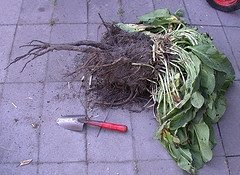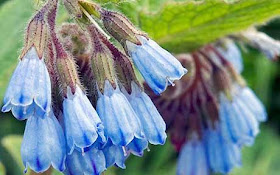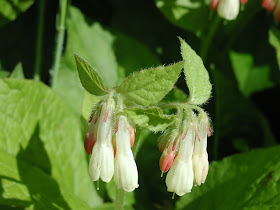Comfrey is a "must have" plant in the Forest Garden.
Common Name: Comfrey
Scientific Names:
- Symphytum asperum (Rough/Prickly Comfrey):
- Symphytum ibericum (Dwarf Comfrey): 12-16” tall and wide
- Symphytum grandiflorum (Large-Flowered Comfrey): 8-12” tall, 18” wide
- Symphytum officianale (Wild/Common/Medicinal Comfrey): 3-5’ tall and wide
- Symphytum orientale (White Comfrey): 2-3’ tall, 12-18” wide
- Symphytum tuberosum (Tuberous Comfrey): 1-2” tall and wide
- Symphytum x uplandicum (Russian/Caucasian/Quaker/Blue Comfrey) = natural hybrid of S. asperum and S. officinale: 1-4’ tall, 3’ wide
Family: Boraginaceae (the Borage or Forget-me-Not Family)
Comfrey growing as companion plants to fruit bushes.
Description:
Comfrey is a fast-growing, perennial, herbaceous, clump-forming plant typically with a deep tap-root (that helps draw up nutrients), large leaves (that can be cut and dropped in place or moved to an area where you want/need those nutrients), and small, pretty flowers (that attract a large number of beneficial insects). It can grow in a wide range of growing conditions. It is an ideal "fertilizer" plant in the Forest Garden.
History:
- Comfrey is a native to Europe and Asia.
- It has been cultivated since around 400 B.C.
- Used medicinally in China for over 2,000 years.
- First brought to Britain in 1800.
- WIld Comfrey was shipped to North America by English immigrants and Russian Comfrey was shipped to Canada in 1954.
Trivia:
- The name "comfrey" comes from the Latin for "grow together" - even ancient people understood the value of Comfrey!
- Also known as “knitbone” after its traditional medicinal use in assisting the healing of broken bones.
Comfrey's small flowers attract a lot of beneficial insects.
USING THIS PLANT
Primary Uses:
- Mulch – can be cut 1-2 x per year (4-5 x per year if fertilized) to about 2 inches above ground and used as a green or “chop and drop” mulch. Avoid harvest in the first season.
- Liquid Fertilizer - steeping chopped Comfrey leaves in water for several weeks produces a thick, dark liquid that can be diluted with water and "fed" to plants.
- Mineral Accumulator – high in potassium, but also phosphorus, calcium, Copper, Iron, and Magnesium
- Ground Cover – lower growing species can tolerate some foot traffic, plant 2-3 feet apart.
- General insect (especially bees) nectar and pollen plant
- Lacewings prefer to lay eggs on Comfrey
- Spiders prefer to overwinter on Comfrey
- Parasitoid Wasps and Spiders prefer to spend time and hunt on and around Comfrey
Secondary Uses:
- Fresh eating – only Symphytum officianale (Common/Medicinal Comfrey) and Symphytum x uplandicum (Russian/Quaker Comfrey). Best when cooked.
- Forage crop for pigs, sheep, and poultry, but reportedly cattle and rabbits don't like fresh leaves (only wilted).
- Medicinal – long history of use in aid of wound and bone healing.
Comfrey has medium to large leaves, and some species have tiny hairs on them.
DESIGNING WITH THIS PLANT
Plant Type: Small Tree to Medium-sized Herbaceous Shrub (while frost resistant, continued freezing weather will kill back above ground growth).
Leaf Type: Deciduous
Forest Garden Use: Herbaceous Layer and Ground Cover/Creeper Layer
Cultivars/Varieties: Many species/varieties available.
Pollination: Self-Pollinating/Self-Fertile
Flowering: May-September (depending on the species)
Life Span: No reliable information available
Comfrey roots are big and deep... perfect to break up hard soil and mine nutrients.
PHYSICAL CHARACTERISTICS OF THIS PLANT
Size: See individual species list above
Roots: Some have rhizomatous and others have fibrous tap roots - deep and expansive
Growth Rate: Fast
Comfrey's flowers come in a wide range of colors: purple, pink, blue, white, yellow... beautiful!
GROWING CONDITIONS FOR THIS PLANT
Light: Prefers full sun
Shade: Tolerates light shade (about 50%)
Moisture: Medium, some species can be a bit more drought tolerant
pH: tolerates a wide range (6.5-8.5)
Special Considerations for Growing:
This is a great species to plant under fruiting trees. If you want to “chop and drop” frequently as a green mulch, consider fertilization with urine (yeah… just pee on it!) as a simple way to boost growth.
Propagation:
- Can be propagated through root cuttings in Winter and Spring – should be planted about 2 inches deep.
- Division in Spring.
- Symphytum officianale (Common/Medicinal Comfrey) can self-seed.
Maintenance: Minimal.
Concerns:
- Can be spreading. (Note: the use of "Bocking 14" cultivar is sterile and prevents its spread)
- Can be hard to eradicate.
- Poisonous – all parts of the plant contains pentacylic alkaloids (regular consumption can cause liver toxicity)
- Note that leaves and stems are covered in small hairs that can irritate the skin.
Harvesting Comfrey... pretty easy with such large leaves.























































